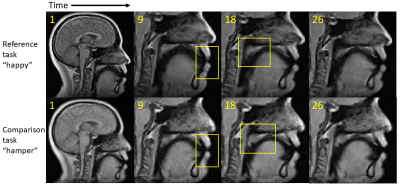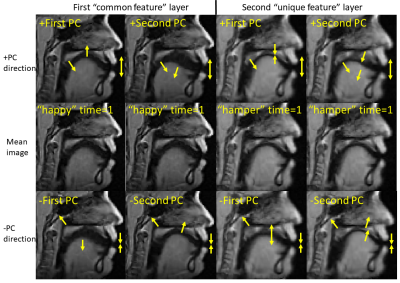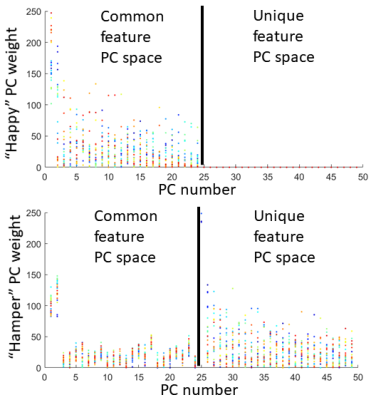2849
Principal Component Characterization of Deformation Variations Using Dynamic Imaging Atlases1Radiology, Massachusetts General Hospital, Boston, MA, United States, 2University of Illinois at Urbana-Champaign, Champaign, IL, United States, 3East Carolina University, Greenville, NC, United States
Synopsis
High-speed dynamic magnetic resonance imaging is a highly efficient tool in capturing vocal tract deformation during speech. However, automated quantification of variations in motion patterns during production of different utterances has been a challenging task due to spatial and temporal misalignments between different image datasets. We present a principal component analysis-based deformation characterization technique built on top of established dynamic speech imaging atlases. Two layers of principal components are extracted to represent common motion and utterance-specific motion, respectively. Comparison between two speech tasks with and without nasalization reveals subtle differences on velopharyngeal deformation reflected in the utterance-specific principal components.
Introduction
Continued developments of fast magnetic resonance imaging (MRI) techniques have greatly facilitated speech production studies [1,2]. Sequences of high-quality image volumes are acquired during real-time speech, enabling vocal tract deformation analysis in both visual and quantitative means. Given multiple MRI datasets of a study population, to achieve automated inter-subject comparison, data normalization methods have been proposed including spatial alignment via statistically constructed dynamic image atlases [3,4] and temporal alignment via additional time stamp data processing [5,6]. However, when comparing image data across different speech tasks, manual assessment remains the only reliable method due to the following reasons: 1) four-dimensional (4D) vocal tract shape during different pronunciations varies intensely both in deformation pattern and in temporal length and 2) direct numerical subtraction between image volumes in different tasks is meaningless because unique motion characteristics are hidden in the entire 4D deformation sequence. In this work, we apply an automated two-layer principal component analysis (PCA) to 4D MRI atlases in multiple speech tasks. The first layer extracts the common motion features across different tasks and the second layer extracts unique features of any specific speech utterance. Hidden motion characteristics are automatically separated and revealed by the two layers of principal components (PCs).Methods
Multi-subject MRI data from a reference speech task and a comparison speech task are acquired. Two sets of 4D dynamic image atlases are constructed using previously proposed method [4] from four healthy subjects’ temporally aligned datasets [6], yielding one image sequence $$$\{I_r(\mathbf{X},t)\},1 \leq t \leq T$$$ for the reference task and another image sequence $$$\{I_c(\mathbf{X},t)\},1 \leq t \leq T$$$ for the comparison task. Note that during atlas construction one specific subject’s anatomy is used as a spatial reference so that $$$\mathbf{X}$$$ in both atlases is the same 3D location. Both sequences are temporally aligned so that $$$t$$$ in both atlases spans the same temporal length $$$T$$$. We use diffeomorphic image registration [7] to extract the deformation fields $$$\{\mathbf{d}_r(\mathbf{X},t)\},2 \leq t \leq T$$$ between every $$$I_r(\mathbf{X},t)$$$ and $$$I_r(\mathbf{X},1)$$$. The same procedure is performed for $$$\{\mathbf{d}_c(\mathbf{X},t)\},2 \leq t \leq T$$$. PCA is used to reveal the maximum differences in a dataset. We perform the first layer of PCA on the deformations $$$\{\mathbf{d}_r(\mathbf{X},t)\}$$$, resulting in $$$\{\mathbf{e}_r^1(\mathbf{X}),...,\mathbf{e}_r^{T-2}(\mathbf{X})\}$$$ showing $$$T-2$$$ principal directions of deformation differences during the reference task. To achieve numerical comparison between the two speech tasks, the second PCA is not performed on the comparison data itself which would result in another intra-task PC decomposition. Instead, the comparison data is modified by subtracting off its “common” motion characteristics to the reference task, i.e., its projections onto the first layer of PC space [8]. Note that the first PCA has centered the reference data by subtracting the mean of all deformations $$$\bar{\mathbf{d}_r}(\mathbf{X})=\sum_t\mathbf{d}_r(\mathbf{X},t)/(T-1)$$$. We need to center the comparison data by $$$\tilde{\mathbf{d}_c}(\mathbf{X},t)=\mathbf{d}_c(\mathbf{X},t)-\bar{\mathbf{d}_r}(\mathbf{X})$$$. The projection $$$p(\tilde{\mathbf{d}_c}(\mathbf{X},t))=(\tilde{\mathbf{d}_c}(\mathbf{X},t) \cdot \mathbf{e}_r^1(\mathbf{X}))\mathbf{e}_r^1(\mathbf{X})+...+(\tilde{\mathbf{d}_c}(\mathbf{X},t) \cdot \mathbf{e}_r^{T-2}(\mathbf{X}))\mathbf{e}_r^{T-2}(\mathbf{X})$$$ is subtracted to modify comparison data by $$$\mathbf{d}^\prime_c(\mathbf{X},t)=\tilde{\mathbf{d}_c}(\mathbf{X},t)-p(\tilde{\mathbf{d}_c}(\mathbf{X},t))$$$. Because the first PC space has a rank of $$$T-2$$$ and the entire two speech tasks have $$$2T-3$$$ degrees of freedom, the rest $$$T-1$$$ principal directions can be any orthogonal vectors. However, all “common” features have been subtracted and stored in the first PC space, all remaining components are therefore unique motion characteristics to the comparison speech task. This is the reason the second PCA is considered an additional layer. Specifically, the covariance matrix of $$$\{\mathbf{d}^\prime_c(\mathbf{X},2),...,\mathbf{d}^\prime_c(\mathbf{X},T)\}$$$ are computed and its eigen decomposition yields $$$T-1$$$ vectors $$$\{\mathbf{e}_c^1(\mathbf{X}),...,\mathbf{e}_c^{T-1}(\mathbf{X})\}$$$ indicating the PC directions for task-specific motion pattern. In total, the two-layer PCA process generates a two-layer PC space $$$\{\mathbf{e}_r^1(\mathbf{X}),...,\mathbf{e}_r^{T-2}(\mathbf{X}),\mathbf{e}_c^1(\mathbf{X}),...,\mathbf{e}_c^{T-1}(\mathbf{X})\}$$$ to represent the common and unique motion characteristics, respectively.Results and Discussion
Pronunciation of utterance “happy” was used as reference task with utterance “hamper” as comparison task in our tests. The two sequences of MRI atlases were constructed using the same four subjects within the same space (Fig. 1). Both pronunciations were temporally aligned in $$$T=26$$$ time frames. The two tasks were designed to reflect similar motion patterns with a unique nasal sound /m/ produced in the comparison task. The first layer of 24-dimensional PC space was constructed using “happy” while the second layer of 25-dimensional PC space used “hamper” to extract its unique deformation. The first two PC directions in both spaces containing 66% of all PC weights were used to deform the first image volumes $$$I_r(\mathbf{X},1)$$$ and $$$I_c(\mathbf{X},1)$$$ to reflect their maximum deformation tendency in both the positive and negative principal vector directions (Fig. 2). The projected weights of both tasks on both PC spaces were computed (Fig. 3), showing that the reference task only has weight on the common motion space while the comparison task has weight on both the common space and its unique motion space. Images deformed using unique PCs were subtracted with the common PCs, showing the uniqueness of nasal pronunciation /m/ is mostly in the velopharyngeal port and near the top of the tongue (Fig. 4).Conclusion
We presented a two-layer PCA on multi-subject speech MRI atlases to automatically extract unique deformation characteristics of the vocal tract in different speech tasks. The analysis quantitatively revealed unique velum and tongue behaviors during nasalization in correspondence to manual assessments.Acknowledgements
This work was supported by NIH R01DE027989.References
[1] Fu, M., Barlaz, M. S., Holtrop, J. L., Perry, J. L., Kuehn, D. P., Shosted, R. K., ... & Sutton, B. P. (2017). High‐frame‐rate full‐vocal‐tract 3D dynamic speech imaging. Magnetic resonance in medicine, 77(4), 1619-1629.
[2] Lingala, S. G., Sutton, B. P., Miquel, M. E., & Nayak, K. S. (2016). Recommendations for real‐time speech MRI. Journal of Magnetic Resonance Imaging, 43(1), 28-44.
[3] Woo, J., Xing, F., Lee, J., Stone, M., & Prince, J. L. (2015, June). Construction of an unbiased spatio-temporal atlas of the tongue during speech. In International Conference on Information Processing in Medical Imaging (pp. 723-732). Springer, Cham.
[4] Woo, J., Xing, F., Lee, J., Stone, M., & Prince, J. L. (2018). A spatio-temporal atlas and statistical model of the tongue during speech from cine-MRI. Computer Methods in Biomechanics and Biomedical Engineering: Imaging & Visualization, 6(5), 520-531.
[5] Woo, J., Xing, F., Stone, M., Green, J., Reese, T. G., Brady, T. J., ... & El Fakhri, G. (2019). Speech map: A statistical multimodal atlas of 4D tongue motion during speech from tagged and cine MR images. Computer Methods in Biomechanics and Biomedical Engineering: Imaging & Visualization, 7(4), 361-373.
[6] Xing, F., Jin, R., Gilbert, I. R., Perry, J. L., Sutton, B. P., Liu, X., El Fakhri, G., Shosted, R. K., & Woo, J. (2021). 4D magnetic resonance imaging atlas construction using temporally aligned audio waveforms in speech. Journal of the Acoustical Society of America,150(5), 3500-3508.
[7] Vercauteren, T., Pennec, X., Perchant, A., & Ayache, N. (2007). Non-parametric diffeomorphic image registration with the demons algorithm. In International Conference on Medical Image Computing and Computer-Assisted Intervention (pp. 319-326). Springer, Berlin, Heidelberg.
[8] Xing, F., Woo, J., Lee, J., Murano, E. Z., Stone, M., & Prince, J. L. (2016). Analysis of 3-D tongue motion from tagged and cine magnetic resonance images. Journal of Speech, Language, and Hearing Research, 59(3), 468-479.
Figures



